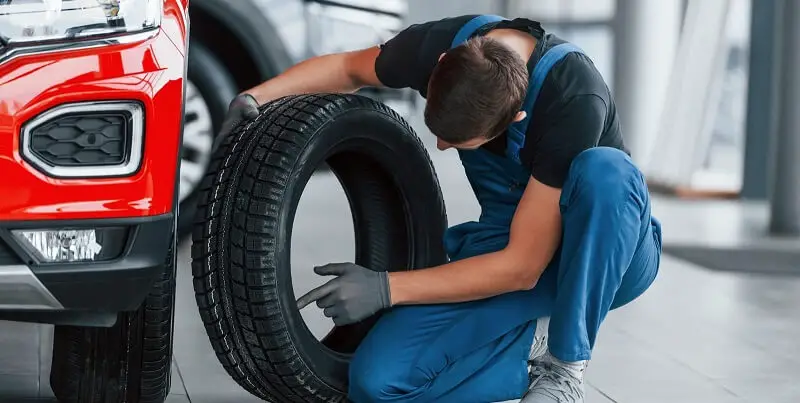Tire Construction Types

Tires are an essential component of any vehicle, responsible for maintaining traction, providing a smooth ride, and ensuring safety. Over the years, tire technology has evolved to accommodate various driving conditions and vehicle requirements.
This article delves into the world of tires by examining four distinct tire types: bias ply, radial, belted bias, and run-flat tires. We will discuss their definitions, constructions, advantages and disadvantages, and applications.
Bias Ply Tires
Bias-ply tires, also known as cross-ply tires, are constructed with layers of fabric, typically nylon, with the cords running diagonally at alternating angles relative to the tire circumference.
Construction & Design
In the construction of bias ply tires, the plies are laid diagonally from bead to bead, with each ply layer overlapping the previous one at an angle, usually between 30 and 60 degrees. This design creates a crisscross pattern that gives the tire a distinctive look and characteristics.
Advantages & Disadvantages
The advantages of bias ply tires include their lower cost and robustness, making them suitable for off-road applications and heavy loads. Additionally, they possess a softer sidewall, providing a more comfortable ride.
However, they have lower fuel efficiency due to increased rolling resistance, reduced handling performance, and a shorter tread life than radial tires.
Applications of Bias Ply Tires
Bias ply tires are commonly used in off-road vehicles, agricultural machinery, and vintage automobiles, where their robustness and lower cost outweigh their disadvantages.
Radial Tires
Radial tires are characterized by their construction, with steel or fabric cords running radially from the tire bead to its tread, perpendicular to the tire’s rotation direction.
Construction & Design
In radial tires, the cords are aligned parallel, with a separate set of steel belts placed circumferentially under the tread to reinforce the tire. This design reduces deformation and heat buildup, improving performance and longevity.
Advantages & Disadvantages
Radial tires offer better fuel efficiency, longer tread life, and better handling than bias-ply tires. Their flexible sidewalls allow for better contact with the road, ensuring a more comfortable ride. However, they tend to be more expensive and less robust than bias-ply tires.
Applications of Radial Tires
Radial tires are widely used in modern passenger cars, light trucks, and motorcycles, where their superior performance and fuel efficiency are highly valued.
Belted Bias Tires
Belted bias tires combine elements of both bias ply and radial tires, featuring the diagonal ply construction of bias tires with additional steel belts for reinforcement.
Construction & Design
Belted bias tires consist of the same diagonal plies found in bias ply tires but with one or more steel belts placed circumferentially under the tread. This hybrid design aims to achieve the benefits of both radial and bias ply tires.
Advantages & Disadvantages
Belted bias tires offer improved tread life and handling compared to traditional bias ply tires while retaining their robustness. However, they are less fuel-efficient and provide a less comfortable ride than radial tires.
Applications of Belted Bias Tires
Belted bias tires are often used in heavy-duty vehicles, such as trucks and buses, where their durability and improved performance are advantageous.
Run-Flat Tires
Run-flat tires are specifically designed to maintain their structural integrity and remain functional even after a puncture, allowing the vehicle to continue driving for a limited distance at a reduced speed.
Construction & Design
Run-flat tires feature reinforced sidewalls and a thicker, more resilient rubber compound. These design elements enable the tire to support the vehicle’s weight even when deflated.
There are two primary types of run-flat tires: self-supporting and support-ring systems. Self-supporting run-flat tires rely on their reinforced sidewalls while support-ring systems incorporate a rigid internal ring that provides support when the tire loses pressure.
Advantages & Disadvantages
The most significant advantage of run-flat tires is their ability to maintain functionality after a puncture, providing increased safety and convenience for drivers. This feature eliminates the need for a spare tire, reducing overall vehicle weight and increasing storage space.
However, run-flat tires are more expensive, provide a harsher ride due to their stiffer construction, and typically have a shorter lifespan than conventional tires. Additionally, not all tire repair shops are equipped to service run-flat tires.
Applications of Run-Flat Tires
Run-flat tires are primarily used in passenger cars and some luxury vehicles where safety, convenience, and weight reduction are prioritized. Several high-end automobile manufacturers, such as BMW and Mercedes-Benz, have adopted run-flat tires as standard equipment on their vehicles.
How Much Tire Tread Is Acceptable?
Tire tread is an essential part of a tire’s performance. It is the portion of the tire that comes into contact with the road and provides traction. The depth of the tread affects a tire’s ability to grip the road, resist wear, and clear water. Most passenger car tires have a tread depth between six and ten 32nds of an inch. Light truck tires may have a tread depth of up to twelve 32nds of an inch.
As a tire wears, the tread becomes shallower. When the tread reaches two 32nds of an inch, it is considered at the legal minimum. However, tires with this little tread are more likely to slip on wet roads and may not provide adequate traction on snow or slippery surfaces. Tires with less than four 32nds of an inch of tread should be replaced.
You can check your tire’s tread depth with a tread depth gauge. These can be purchased at most auto parts stores. To use one, insert the gauge into the tread at several points around the tire. The tire should be replaced if the tread depth is less than four 32nds of an inch.
Conclusion
Tire technology has come a long way, with various types tailored to specific applications and driving conditions. Bias ply tires offer robustness and affordability, making them suitable for off-road and heavy-duty use. Radial tires provide improved fuel efficiency, handling, and longevity, making them popular for modern passenger vehicles.
Belted bias tires combine elements of both designs for a balance of durability and performance. Lastly, run-flat tires prioritize safety and convenience by remaining functional even after a puncture.
Understanding the differences between these tire types can help drivers make informed decisions when choosing the best tire for their vehicle and driving conditions. Whether prioritizing fuel efficiency, performance, durability, or safety, tire technology is designed to meet those needs.

